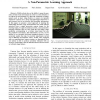Free Online Productivity Tools
i2Speak
i2Symbol
i2OCR
iTex2Img
iWeb2Print
iWeb2Shot
i2Type
iPdf2Split
iPdf2Merge
i2Bopomofo
i2Arabic
i2Style
i2Image
i2PDF
iLatex2Rtf
Sci2ools
ICRA
2008
IEEE
2008
IEEE
Monocular range sensing: A non-parametric learning approach
Abstract— Mobile robots rely on the ability to sense the geometry of their local environment in order to avoid obstacles or to explore the surroundings. For this task, dedicated proximity sensors such as laser range finders or sonars are typically employed. Cameras are a cheap and lightweight alternative to such sensors, but do not directly offer proximity information. In this paper, we present a novel approach to learning the relationship between range measurements and visual features extracted from a single monocular camera image. As the learning engine, we apply Gaussian processes, a non-parametric learning technique that not only yields the most likely range prediction corresponding to a certain visual input but also the predictive uncertainty. This information, in turn, can be utilized in an extended grid-based mapping scheme to more accurately update the map. In practical experiments carried out in different environments with a mobile robot equipped with an omnidirectional cam...
| Added | 30 May 2010 |
| Updated | 30 May 2010 |
| Type | Conference |
| Year | 2008 |
| Where | ICRA |
| Authors | Christian Plagemann, Felix Endres, Juergen Michael Hess, Cyrill Stachniss, Wolfram Burgard |
Comments (0)

